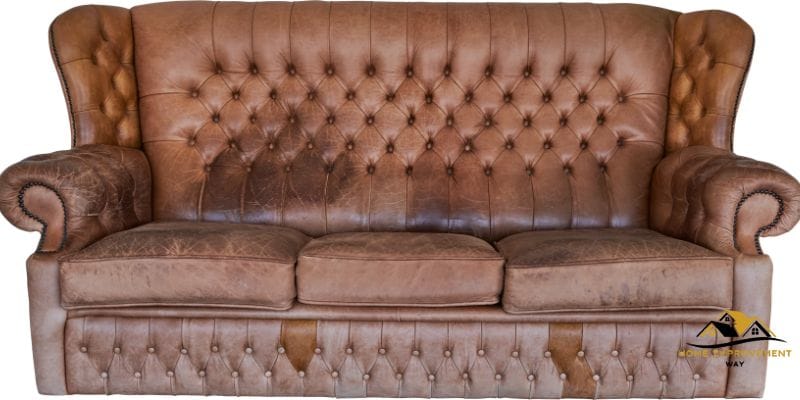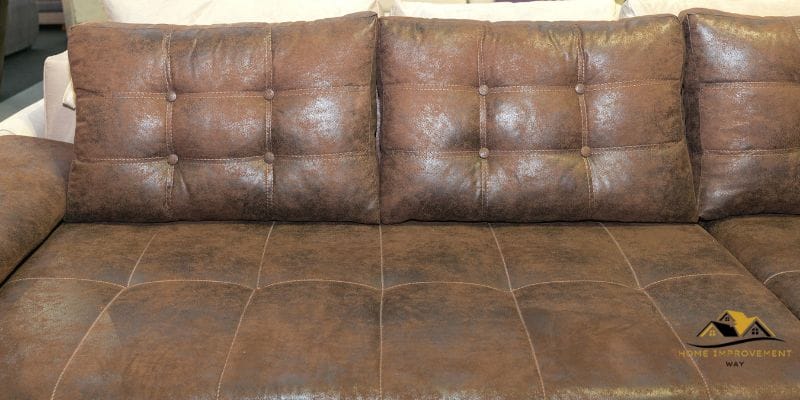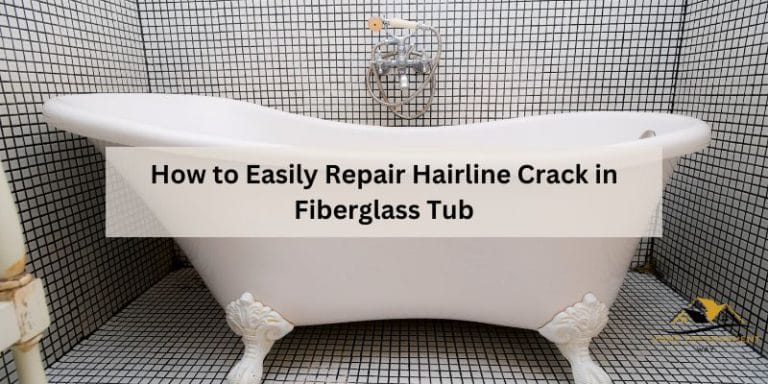How to Rescue Your Peeling Faux Leather Couch: Expert Fixes
To fix a peeling faux leather couch, you can use a leather repair kit to repair the peeling areas and apply a leather conditioner to protect the surface. Are you dealing with a peeling faux leather couch?
Don’t worry – there’s a solution! Over time, faux leather can start to peel and lose its original appearance. Fortunately, you can easily fix this issue with some simple steps. By using a leather repair kit, you can mend the peeling sections and restore the couch’s look.
Additionally, applying a leather conditioner afterward helps to maintain and protect the surface from further damage. We will walk you through the process of fixing a peeling faux leather couch, so you can enjoy its beauty for years to come.
Understanding Faux Leather Couches
Discover effective methods for fixing peeling faux leather couches, ensuring they maintain their appeal and durability. From simple steps like cleaning and moisturizing to more advanced approaches like using leather repair kits, this guide provides practical solutions to restore your faux leather couch to its former glory.
When it comes to furniture, faux leather couches have become a popular choice for many households. They offer the look and feel of genuine leather at a more affordable price. However, it is important to understand the characteristics of faux leather and how to properly care for it to ensure its longevity. In this section, we will delve into the concept of faux leather and explain why these couches tend to peel over time.

What Is Faux Leather?
Faux leather, also known as synthetic leather or pleather, is a man-made material designed to mimic the appearance and texture of genuine leather. It is primarily composed of a fabric base, typically polyester or cotton, which is coated with a layer of polyurethane (PU) or polyvinyl chloride (PVC). This coating gives faux leather its characteristic smooth and glossy finish, resembling the real thing.
Why Do Faux Leather Couches Peel?
Despite its durability, faux leather couches are prone to peeling over time. There are several factors that contribute to this issue:
1. Poor quality materials: Some faux leather couches are made using subpar materials, resulting in a higher probability of peeling. These lower-quality options tend to have a thin and weak PU or PVC coating, making them more susceptible to wear and tear.
2. Direct sunlight: Prolonged exposure to sunlight can cause faux leather to fade and deteriorate. UV rays can weaken the protective coating, leading to peeling and cracking. It is essential to keep your faux leather couch away from direct sunlight or use window coverings to shield it from the sun’s harmful rays.
3. Mechanical stress: Over time, constant use and friction can cause the faux leather upholstery to peel. Common occurrences such as sitting, reclining, or even pets jumping on the couch can eventually wear down the protective layer, resulting in unsightly peeling.
4. Lack of proper maintenance: Like any other piece of furniture, faux leather couches require regular cleaning and conditioning. Failure to do so can lead to the accumulation of dirt, oils, and other contaminants, which can weaken the protective coating and accelerate peeling.
To prevent peeling and preserve the appearance of your faux leather couch, it is crucial to take proper care of it. By understanding the causes of peeling and implementing preventive measures, you can extend the lifespan of your faux leather couch and enjoy its beauty and comfort for years to come.

Preventing Peeling On Faux Leather Couches
A faux leather couch can be an attractive and affordable addition to any living space. However, if not properly cared for, faux leather couches are prone to peeling, which can significantly diminish their appearance and longevity. To ensure your faux leather couch stays in top-notch condition, follow these simple tips on preventing peeling.
Choosing High-quality Faux Leather Couches
When shopping for a faux leather couch, it’s crucial to choose one made from high-quality materials. Opt for couches that are made from top-grain or full-grain faux leather. These types of faux leather are more durable and less prone to peeling. Additionally, be sure to inspect the stitching and overall construction of the couch to ensure it is well-made and designed to withstand everyday use.
Proper Maintenance And Cleaning
Maintaining and cleaning your faux leather couch regularly is key to preventing peeling. Make it a habit to wipe down the couch with a soft, microfiber cloth or sponge at least once a week to remove any dust and debris. Avoid using abrasive cleaners or brushes that could damage the surface. Instead, use a mild soap or specialized faux leather cleaner that is specifically formulated for this type of material.
Remember to blot any spills immediately to prevent staining and make sure to clean the entire surface of the couch, not just the affected area. This will help maintain the overall appearance and prevent uneven wear and tear that can lead to peeling.
Avoiding Harsh Chemicals
Harsh chemicals can be extremely detrimental to faux leather couches, causing them to peel and crack over time. It is important to avoid using any cleaning products that contain bleach, ammonia, or other harsh chemicals. These substances can strip away the protective coating on the faux leather, leaving it vulnerable to peeling. Stick to gentle, non-abrasive cleaners and always check the product labels to ensure they are safe for use on faux leather.
Furthermore, when placing any items on your faux leather couch, be cautious about using sharp objects or items with rough surfaces, as these can scratch or puncture the faux leather, leading to peeling in the long run.
Fixing Peeling Faux Leather Couches
Assessing the damage:
If your faux leather couch is starting to peel and show signs of wear, it’s crucial to assess the extent of the damage before deciding on the most suitable course of action to fix it. By carefully examining the peeling areas, you’ll be able to determine whether the damage is minor and can be repaired or if it’s more severe and requires replacement or reupholstering.
Repairing small peeling areas:
If the peeling on your faux leather couch is limited to small areas, you may be able to fix it yourself using some simple steps. Start by gently cleaning the affected area with a mild soap solution and a soft cloth, removing any dirt or debris that could interfere with the repair. Once the surface is clean, apply a leather repair kit, following the manufacturer’s instructions carefully. These kits typically include a filler compound that can be used to fill in the peeling spots and a color-matching paint or dye to restore the couch’s appearance.
Replacing or reupholstering the couch:
If the peeling on your faux leather couch is extensive and cannot be effectively repaired, you may need to consider replacing or reupholstering it. Replacing the couch entirely would involve purchasing a new one, while reupholstering would entail removing the damaged faux leather and replacing it with new material. Both options have their pros and cons, so it’s important to weigh the cost and effort involved against the value and longevity of the couch. Ultimately, the decision will depend on your budget, personal preference, and the overall condition of the couch.
Assessing The Damage
- Examine the peeling areas for size and severity
- Determine whether the damage is repairable or requires replacement/reupholstering
Repairing Small Peeling Areas
- Clean the affected area with a mild soap solution and a soft cloth
- Apply a leather repair kit, following the manufacturer’s instructions carefully
- Fill in the peeling spots with the filler compound
- Restore the couch’s appearance using the color-matching paint or dye
Replacing Or Reupholstering The Couch
- Weigh the pros and cons of replacing versus reupholstering
- Consider the cost, effort, and overall condition of the couch
- Make a decision based on your budget and personal preference
Conclusion
To sum up, fixing a peeling faux leather couch is a simple process that can be achieved with a few steps. By cleaning the surface, applying a leather repair kit, and providing proper maintenance, you can restore the couch to its former glory.
Remember to always follow the instructions of the repair kit and consult a professional if needed. With these tips, you can extend the lifespan of your faux leather couch and enjoy its beauty for years to come.







